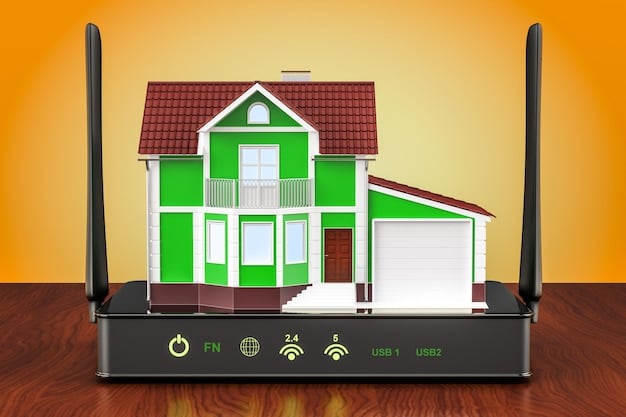Wi-Fi 6E Routers: Upgrade Your Home Network for Faster Speeds

Anúncios
Upgrading your home network with a Wi-Fi 6E router is essential for unlocking unprecedented speeds, lower latency, and enhanced capacity, crucial for modern smart homes and demanding online activities.
The digital landscape of our homes is constantly evolving, with more devices demanding faster and more reliable internet connections. In this dynamic environment, Wi-Fi 6E routers: Upgrade Your Home Network for Faster Speeds and Lower Latency represents a pivotal advancement. It promises to revolutionize how we experience connectivity, addressing the growing strain on traditional Wi-Fi bands with unparalleled efficiency and performance.
The advent of Wi-Fi 6E: What sets it apart?
Wi-Fi technology has progressed rapidly, with each new iteration bringing significant improvements. Wi-Fi 6E, the latest evolution, builds upon the foundational strengths of Wi-Fi 6 by introducing a groundbreaking feature: access to the 6 GHz frequency band. This expansion is not merely an incremental upgrade; it represents a fundamental shift in wireless communication, offering a truly uncongested and high-capacity spectrum for data transmission.
The 6 GHz band is pristine, meaning it is not burdened by legacy Wi-Fi traffic or interference from household appliances, which typically plague the 2.4 GHz and 5 GHz bands. This clean spectrum provides an unprecedented opportunity for devices to communicate with minimal interference, resulting in significantly faster speeds, lower latency, and greater reliability. For the average homeowner, this translates into smoother streaming of 8K content, lag-free online gaming, and efficient handling of numerous smart home devices simultaneously.
Unlocking new possibilities with the 6 GHz band
The primary differentiator of Wi-Fi 6E is its utilization of the 6 GHz band. This additional spectrum effectively triples the available airwaves for Wi-Fi, offering 14 new 80 MHz channels and seven new 160 MHz channels. These wider channels are critical for achieving multi-gigabit speeds, something that was previously difficult or impossible on the crowded 2.4 GHz and 5 GHz bands.
- Reduced Congestion: The 6 GHz band is exclusive to Wi-Fi 6E devices, eliminating interference from older Wi-Fi standards.
- Wider Channels: Support for 160 MHz channels dramatically increases bandwidth, leading to higher throughput.
- Lower Latency: Less interference and efficient data handling contribute to quicker response times for latency-sensitive applications.
The benefits for the modern home
For homes increasingly filled with smart devices, laptops, smartphones, and entertainment systems, Wi-Fi 6E offers a robust solution to network bottlenecks. Imagine a household where multiple members are simultaneously streaming 4K content, participating in video conferences, and playing online games, all without a hint of lag or buffering. This is the promise of Wi-Fi 6E.
It’s not just about raw speed; it’s also about efficiency. Wi-Fi 6E incorporates technologies like OFDMA (Orthogonal Frequency-Division Multiple Access) and MU-MIMO (Multiple-User, Multiple-Input, Multiple-Output), which were refined in Wi-Fi 6. OFDMA allows a single channel to be divided into smaller sub-channels, enabling simultaneous transmission to multiple devices, thus improving overall network efficiency and reducing latency. MU-MIMO permits the router to communicate with multiple devices at once, rather than one by one, further enhancing throughput.
Ultimately, Wi-Fi 6E routers provide a future-proofed network that can handle the escalating demands of next-generation technology and the increasing number of connected devices in our homes. The investment in a 6E router is an investment in a seamless and high-performance digital lifestyle.
Key features of Wi-Fi 6E routers
Beyond the fundamental inclusion of the 6 GHz band, Wi-Fi 6E inherits and enhances several critical features from Wi-Fi 6 (802.11ax), making it a powerhouse for modern home networks. These features collectively contribute to the improved speeds, reduced latency, and increased capacity that define the 6E experience.
One of the most significant advancements is Targeted Wake Time (TWT), a power-saving feature designed for devices. TWT allows devices to negotiate when and how often they will wake up to send or receive data, prolonging battery life for IoT devices and other connected gadgets. This efficiency not only saves power but also reduces network congestion by scheduling transmissions more effectively.
OFDMA and MU-MIMO revisited
While not exclusive to Wi-Fi 6E, OFDMA and MU-MIMO are integral to its superior performance. OFDMA revolutionizes how data is transmitted by allowing a single data stream to be divided and sent to multiple devices simultaneously. This is particularly beneficial in environments with many low-bandwidth IoT devices, as it drastically reduces the time these devices spend competing for airtime.
- OFDMA (Orthogonal Frequency-Division Multiple Access): Improves efficiency by enabling simultaneous data transmission to multiple devices using sub-channels, optimizing bandwidth utilization.
- MU-MIMO (Multi-User, Multiple-Input, Multiple-Output): Allows the router to communicate with several devices concurrently, significantly increasing network capacity and speed.
- Spatial Reuse (BSS Coloring): Helps in minimizing co-channel interference by enabling devices to identify transmissions from other networks and adjust their behavior accordingly.
MU-MIMO, on the other hand, allows a router to communicate with multiple devices simultaneously through multiple antennas. While Wi-Fi 5 introduced downlink MU-MIMO, Wi-Fi 6 and 6E enhance this with both uplink and downlink capabilities, allowing for more efficient two-way communication. This means less waiting for data, leading to a smoother experience across all connected devices.

Enhanced security with WPA3
Network security is paramount, and Wi-Fi 6E standardizes the use of WPA3 (Wi-Fi Protected Access 3). WPA3 offers significant improvements over its predecessor, WPA2, providing more robust encryption and enhanced protection against brute-force attacks. This means your home network is better protected from unauthorized access and data interception, giving you peace of mind.
WPA3 also simplifies the process of configuring security settings for devices without a display, such as many smart home gadgets, through Wi-Fi Device Provisioning Protocol (DPP). This combines ease of use with strong security measures, ensuring that even the most basic smart devices are protected.
The combination of these features—the untamed 6 GHz band, efficient data handling with OFDMA and MU-MIMO, power efficiency with TWT, and robust security with WPA3—establishes Wi-Fi 6E as a transformative technology. It’s designed to not only meet the current demands of a connected home but also to anticipate and handle the needs of future innovations, providing a truly superior wireless experience.
Choosing the right Wi-Fi 6E router for your home
Selecting the ideal Wi-Fi 6E router involves more than just picking the newest model. It requires a thoughtful consideration of your home’s size, the number of devices you use, your internet service provider (ISP) plan, and specific features that align with your lifestyle. The market for Wi-Fi 6E routers is growing, offering a variety of options from basic models to high-performance gaming routers and mesh systems.
Understanding your needs
Before diving into specifications, assess your current and anticipated network demands. Do you live in a small apartment or a large multi-story house? How many people in your household use the internet simultaneously? Are you a casual browser, heavy streamer, or a serious online gamer? These questions will guide you toward the appropriate router type and performance tier.
- Home Size: Larger homes or those with many obstacles (walls, floors) may benefit from a mesh Wi-Fi 6E system for broader coverage.
- Number of Devices: More devices, especially high-bandwidth ones, necessitate a router with higher capacity and better processing power.
- Internet Plan: Ensure your router can support speeds equal to or greater than your ISP’s plan to avoid bottlenecks.
Key specifications to consider
When comparing Wi-Fi 6E routers, several technical specifications stand out as crucial indicators of performance and capability. Look for routers that explicitly advertise support for the 6 GHz band, ensuring you’re getting true 6E functionality.
The number of antennas (often referred to as streams) indicates a router’s MU-MIMO capabilities and overall capacity. More streams generally mean better performance for multiple devices. Additionally, check for Ethernet port speeds; a 2.5 Gbps or 10 Gbps WAN/LAN port is essential to take full advantage of multi-gigabit internet connections.
Mesh Wi-Fi 6E systems versus traditional routers
For larger homes or those with dead zones, a single traditional Wi-Fi 6E router might not provide adequate coverage. In such cases, a mesh Wi-Fi 6E system is an excellent alternative. Mesh systems consist of multiple nodes that work together to create a unified, seamless network throughout your home, often with a dedicated backhaul for communication between nodes, enhancing performance.
While traditional routers typically offer more granular control over network settings and may be preferred by advanced users, modern mesh systems have become incredibly user-friendly, often managed via a smartphone app. Their ability to deliver consistent high-speed Wi-Fi across large areas makes them highly appealing for extensive smart homes.
Ultimately, the best Wi-Fi 6E router is one that aligns with your specific needs and budget, providing a future-ready network capable of supporting the evolving demands of your connected life. Taking the time to research and understand these factors will lead to a satisfying and performant home network experience.
Installation and setup: Getting started with your Wi-Fi 6E router
The prospect of setting up a new router can seem daunting, but modern Wi-Fi 6E routers are designed with user-friendliness in mind. The installation process is generally straightforward, typically involving a few simple steps that can be completed even by those with limited technical expertise. Manufacturers provide detailed guides and often companion smartphone apps to walk you through each stage.
Pre-installation checklist
Before you even unbox your new router, a little preparation can save time and potential headaches. Ensure you have your existing modem’s credentials (if separate from the router), an Ethernet cable, and access to a power outlet near your preferred router location. Position is crucial; try to place the router in a central location, away from obstructions and other electronic devices that could cause interference.
- Location: Choose a central, elevated spot for optimal signal distribution.
- Power: Ensure a stable power source is available.
- Cables: Have necessary Ethernet cables ready for initial setup and wired connections.
The step-by-step setup process
Most Wi-Fi 6E routers follow a similar setup procedure. First, connect your new router to your modem using the provided Ethernet cable—usually to the WAN or Internet port on the router. Then, power on both your modem and router, waiting for them to fully boot up and establish a connection, indicated by stable LED lights.
Next, connect a device (like a laptop or smartphone) to the router’s default Wi-Fi network (SSID and password typically found on a label on the router or in the quick start guide). Once connected, open a web browser and navigate to the router’s setup page (often an IP address like 192.168.1.1 or a manufacturer-specific web address). Follow the on-screen prompts to customize your network name (SSID), set a strong password, and configure any additional settings like parental controls or guest networks.
Many modern Wi-Fi 6E routers also offer app-based setup, which can be even simpler. You download the manufacturer’s app, and it guides you through the process, often detecting the router automatically and prompting you to scan a QR code for quick configuration. This method is particularly convenient for mobile users.
Optimizing your Wi-Fi 6E network
Once your router is up and running, there are several steps you can take to optimize its performance. Ensure your devices supporting 6E are connecting to the 6 GHz band; some routers allow you to create separate SSIDs for each band, while others use a single SSID and intelligently steer devices to the best band. Keep your router’s firmware updated, as manufacturers frequently release updates that improve performance, add features, and patch security vulnerabilities. Periodically check for interference sources and adjust antenna orientation if your router has external antennas.
By following these steps, you can ensure your Wi-Fi 6E router is properly installed and configured to deliver the fast, reliable, and low-latency connectivity it’s designed for, maximizing your home network’s potential.
Maximizing your Wi-Fi 6E experience: Tips and tricks
Having a Wi-Fi 6E router is a significant first step, but optimizing its performance requires more than just plug-and-play. To truly unlock the full potential of your upgraded network and enjoy the benefits of faster speeds and lower latency, a few strategic adjustments and considerations can make a substantial difference.
Firmware updates are vital
One of the most overlooked aspects of router maintenance is keeping its firmware updated. Router manufacturers regularly release firmware updates that can improve performance, enhance security, fix bugs, and even introduce new features. Neglecting these updates can leave your network vulnerable or prevent it from operating at its peak efficiency. Most modern routers allow for easy, often automated, firmware updates via their web interface or a dedicated smartphone app. Make it a routine to check for and install these updates.
- Regular Checks: Periodically check the manufacturer’s website or app for new firmware versions.
- Automated Updates: Enable automatic updates if your router offers this feature.
- Security Patches: Firmware updates often include crucial security fixes, protecting your network from emerging threats.
Strategic device placement
While Wi-Fi 6E boasts superior range and penetration compared to older standards, physical placement still matters. Position your router in a central location within your home, ideally elevated and away from large metal objects, thick walls, and other electronics that emit radio waves (like microwaves or cordless phones). These can interfere with Wi-Fi signals and diminish their strength. For multi-story homes, experiment with placement on different floors to find a sweet spot that covers most areas effectively.
For homes with extensive square footage or numerous floors, considering a mesh Wi-Fi 6E system becomes even more critical. These systems distribute multiple access points throughout your home, providing seamless coverage and ensuring that every corner receives a strong Wi-Fi 6E signal. The intelligent routing within a mesh system often means devices automatically connect to the nearest and strongest access point, optimizing performance as you move around.

Prioritizing network traffic (QoS)
Many Wi-Fi 6E routers come with Quality of Service (QoS) features. QoS allows you to prioritize certain types of network traffic, ensuring that critical applications like online gaming or video conferencing receive preferential bandwidth over less time-sensitive activities like background downloads. By configuring QoS settings, you can guarantee a smoother experience for your most important online tasks, even when your network is busy.
Some routers offer smart QoS, which automatically detects and prioritizes common applications. Others provide manual controls, allowing you to fine-tune prioritization based on device or application type. Leveraging these features ensures that your Wi-Fi 6E network operates not just fast, but intelligently, adapting to your usage patterns and delivering an optimized experience for every connected device.
Experimenting with these tips can significantly enhance your Wi-Fi 6E experience, transforming your home network into a robust, high-performance backbone for all your digital needs.
Future-proofing your home with Wi-Fi 6E
Investing in a Wi-Fi 6E router is not just about addressing current connectivity needs; it’s a strategic move to future-proof your home network. As technology continues its rapid advancement, new devices and applications will inevitably demand even more from our internet connections. Wi-Fi 6E, with its expanded bandwidth and enhanced efficiency, is ideally positioned to meet these evolving challenges.
The rise of high-bandwidth applications
The trend towards higher resolution streaming (4K, 8K, and beyond), immersive virtual reality (VR) and augmented reality (AR) experiences, and increasingly sophisticated smart home ecosystems is accelerating. These applications are incredibly data-intensive and latency-sensitive. Traditional Wi-Fi standards, particularly in crowded environments, often struggle to keep up, leading to buffering, lag, and unreliable connections.
Wi-Fi 6E’s ability to utilize the uncongested 6 GHz band means it can deliver the massive bandwidth and ultra-low latency required for these next-generation experiences. Imagine streaming an 8K movie while simultaneously engaging in a VR gaming session, all without a hitch. This level of performance becomes a reality with a Wi-Fi 6E network.
Supporting the expanding smart home
Our homes are becoming smarter, with everything from thermostats and lighting to security cameras and appliances connecting to the network. While many IoT devices don’t require immense bandwidth, their sheer number can overwhelm older routers, leading to network congestion and slower overall performance. Wi-Fi 6E’s efficiency features, such as OFDMA and TWT, are perfectly suited to manage this growing ecosystem of connected devices.
OFDMA allows the router to communicate with multiple devices simultaneously, optimizing bandwidth usage for even small data packets from IoT sensors. TWT, as discussed earlier, helps these devices conserve power and reduces network traffic by scheduling their wake times. This means your smart home runs more smoothly, and devices can operate more reliably without competing for precious airtime.
Longevity and value for money
While a Wi-Fi 6E router might represent a higher upfront investment compared to older models, its long-term value is significant. By adopting the latest standard, you ensure that your network is prepared for the influx of future Wi-Fi 6E-compatible devices, which will become increasingly common in the coming years. This eliminates the need for frequent router upgrades, saving you money and hassle in the long run.
Furthermore, an efficient and robust Wi-Fi 6E network can actually improve the performance of your existing devices, even those not 6E-compatible, by reducing overall network congestion. The benefits of Wi-Fi 6E extend beyond just raw speed; they encompass reliability, efficiency, and preparedness for the digital future. It’s an investment in a seamless and high-performance connected lifestyle for years to come.
Troubleshooting common Wi-Fi 6E issues
Even with the most advanced technology, occasional hiccups can occur. While Wi-Fi 6E routers offer superior performance and reliability, understanding how to troubleshoot common issues can save you time and frustration. Many problems have simple solutions, and a systematic approach will help you quickly identify and resolve them.
Connectivity problems: When devices won’t connect to 6 GHz
A common concern is when Wi-Fi 6E-compatible devices don’t seem to connect to the 6 GHz band. This can happen for several reasons. First, ensure your device truly supports Wi-Fi 6E; not all Wi-Fi 6 devices are 6E-compatible. Check your device’s specifications or look for the “Wi-Fi 6E” logo.
- Device Compatibility: Confirm your device explicitly supports Wi-Fi 6E (6 GHz band).
- Driver Updates: Ensure your device’s wireless adapter drivers are up to date.
- Router Configuration: Check router settings to confirm the 6 GHz band is enabled and broadcasting.
Sometimes, routers use a single SSID for all bands and intelligently steer devices. If you suspect your device isn’t on 6 GHz, try separating the SSIDs for each band in your router’s settings (e.g., “MyWiF i_2.4GHz”, “MyWiFi_5GHz”, “MyWiFi_6GHz”). Then, manually connect your 6E device to the 6 GHz network. Also, ensure your device’s wireless adapter drivers are up to date, as outdated drivers can sometimes prevent proper band utilization.
Slow speeds or intermittent connections
If you’re experiencing slower-than-expected speeds or frequent disconnections, several factors could be at play. While the 6 GHz band is less prone to interference, distance and physical obstructions (like thick walls or several floors) can still attenuate the signal. Try moving your device closer to the router or consider adjusting the router’s position. Objects like fish tanks, large mirrors, or concrete walls are notorious for blocking Wi-Fi signals.
Another potential culprit is interference from other devices creating electromagnetic noise. While the 6 GHz band is relatively clean, very close proximity to microwaves, certain cordless phones, or even poorly shielded electronics could still cause minor issues. Try temporarily switching off nearby electronics to see if performance improves. Also, check for strong signals from neighboring Wi-Fi networks, especially in dense residential areas. While 6E helps mitigate this, extreme congestion can still have an impact.
Router overheating and firmware issues
Overheating can lead to performance degradation or even system crashes. Ensure your router is in a well-ventilated area and not enclosed in a cabinet or against a wall that restricts airflow. Dust buildup can also contribute to overheating; periodically clean the vents to ensure proper cooling.
As mentioned previously, outdated or corrupted firmware can cause a myriad of problems, from connectivity issues to slow speeds. If you’re encountering persistent problems, perform a factory reset on your router and then immediately update to the latest firmware. This often resolves underlying software glitches. If problems persist after trying these troubleshooting steps, consult your router’s support documentation or contact customer service for further assistance. A well-maintained and properly configured Wi-Fi 6E network will provide a robust and enjoyable internet experience.
| Key Point | Brief Description |
|---|---|
| 🚀 Speed Boost | Unlocks the 6 GHz band for unprecedented multi-gigabit speeds and higher capacity. |
| ⚡ Low Latency | Less interference on 6 GHz ensures quicker response times for gaming and streaming. |
| 🏠 Home Capacity | Handles more devices simultaneously with OFDMA and MU-MIMO, perfect for smart homes. |
| 🛡️ Enhanced Security | WPA3 encryption provides stronger protection against cyber threats. |
Frequently asked questions about Wi-Fi 6E routers
The 6 GHz band is a new, contiguous block of unlicensed spectrum exclusively available for Wi-Fi 6E devices. Unlike the crowded 2.4 GHz and 5 GHz bands, 6 GHz offers significantly more channels, including wide 160 MHz channels, which are crucial for achieving multi-gigabit speeds and drastically reducing network congestion and interference from older Wi-Fi standards or other devices.
Yes, to fully benefit from Wi-Fi 6E’s capabilities, especially the 6 GHz band, your devices (smartphones, laptops, tablets, etc.) must also be Wi-Fi 6E compatible. While a Wi-Fi 6E router is backward compatible with older Wi-Fi standards (2.4 GHz and 5 GHz), only 6E-enabled devices can connect to and utilize the new, uncongested 6 GHz spectrum for optimal performance.
A Wi-Fi 6E router can significantly improve your *local network* speeds and efficiency, but it cannot increase your internet speed beyond what your Internet Service Provider (ISP) plan allows. If your ISP plan is, for example, 300 Mbps, your Wi-Fi 6E router can deliver that speed reliably over Wi-Fi, but it won’t magically make it 1 Gbps. It removes internal bottlenecks.
For large homes, multi-story residences, or those with many dead spots, a mesh Wi-Fi 6E system is highly recommended. While a single Wi-Fi 6E router offers excellent coverage, mesh systems utilize multiple nodes to create a seamless, whole-home network, ensuring robust signal strength and consistent speeds even in challenging environments. They are especially beneficial for widespread smart home device coverage.
Wi-Fi 6E reduces latency primarily by operating on the uncongested 6 GHz band, which means less interference and “airtime” contention. Additionally, technologies like OFDMA efficiently manage traffic by allowing multiple devices to transmit data simultaneously in a coordinated manner, reducing queuing delays. These factors combine to provide a quicker, more responsive connection vital for competitive online gaming and real-time applications.
Conclusion
The transition to a Wi-Fi 6E router represents a significant step forward in home networking, offering a robust solution to the increasing demands of our connected lives. By leveraging the pristine 6 GHz band alongside advanced Wi-Fi 6 technologies, these routers deliver unparalleled speeds, significantly lower latency, and enhanced capacity, ensuring a smoother and more reliable experience for every device in your home. It’s an investment that not only solves today’s connectivity challenges but also future-proofs your network for the innovations yet to come, enabling seamless streaming, lag-free gaming, and a truly responsive smart home ecosystem.





